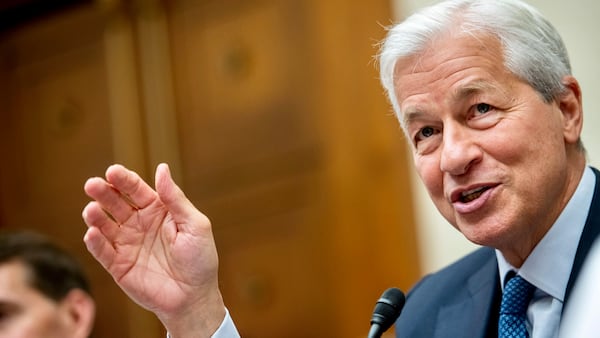- JPMorgan, Jane Street and other authorised participants may be using Bitcoin futures ETFs to hedge their spot ETF activities.
- Despite JPMorgan’s CEO railing against crypto last week, his firm is a key player in the new spot Bitcoin ETF market.
Spot Bitcoin exchange-traded funds continued to smash expectations last week, and some of Wall Street’s biggest names are playing a crucial role despite bosses like JPMorgan CEO Jamie Dimon continuing to criticise Bitcoin.
So-called authorised participants include JPMorgan and speed-trading giants Jane Street and Virtu Financial. All of three of these firms are included as APs for BlackRock’s spot Bitcoin ETFs, according to SEC filings.
APs ensure spot Bitcoin ETFs launched by the likes of BlackRock and Fidelity trade as close as possible to the underlying value of the Bitcoin they hold, helping investors get the best deal possible.
Despite JPMorgan’s role in the Bitcoin ETF ecosystem, Dimon called Bitcoin a “Pet Rock” at the World Economic Forum’s annual meeting in Davos — his latest in a long line of crypto-critical comments.
Even as Dimon stayed true to his Bitcoin-bashing form, however, traditional financial firms are playing a crucial role with the new ETFs — and they’re doing a good job.
‘Crushed it’
The Wall Street bigwigs “crushed it” on the first day of trading, Eric Balchunas, an ETF analyst at Bloomberg Intelligence, said.
There had been worries that the ETFs shares might trade at a higher price than the Bitcoin they represent, Balchunas said, but authorised participants ensured that risk was mitigated.
Based on whether the ETF is trading above or below its net asset value — the cost of the underlying Bitcoin it holds — these firms will create or redeem shares.
If it trades higher, they’ll need to create more shares, adding supply to the market and lowering the price. If it trades lower, then managers will redeem shares for cash, reducing supply.
Authorised participants don’t handle Bitcoin directly, as creations and redemptions are done with cash rather than so-called “in-kind” redemptions issuers had fought for.
A week on from launch, these newborn ETFs continue to trade in a tight range to their net asset value.
Why does this matter? Tighter spreads mean better deals for investors, and a better chance at increasing flows into the ETFs, Balchunas said on Wednesday.
Sophisticated strategies
The use of cash creations and redemptions, instead of in-kind creations, means there’s a “settlement period gap,” Coinbase’s head of institutional research, David Duong, told DL News via email.
This gap is the time between authorised participants receiving buy orders and when new shares are created. As a result, authorised participants will need to protect themselves from price movements during these periods, likely using pre-existing regulated products.
Bitcoin futures ETFs experienced a brief renaissance following the launch of spot funds. ProShares’ Bitcoin futures ETF, BITO, processed $2 billion in trading volume on the day the spot ETFs launched — beating its previous record by more than 50%, according to Coinbase.
Volumes dropped about 75% a week later, trading $503 million in volume on January 18.
Institutional investors might be using these types of funds to protect themselves during the settlement period gap.
Liquid pre-existing products such as Bitcoin futures ETFs act as a “parking spot,” of sorts, Balchunas said in December. Since BITO is highly liquid — meaning holders can sell shares into cash with ease — firms managing the spot Bitcoin ETFs can hold it as a sort of transition tool to reduce volatility risks as they create and redeem shares in the newly launched spot Bitcoin ETFs.
“Despite this drop, we view BITO as a continued integral part of the Bitcoin ETF space,” Coinbase’s report said, referring to the 75% plunge in trading this week.
Authorised participants “will continue to rely on regulated means of hedging themselves, such as long CME futures or long BITO when creating shares,” Coinbase said.
These products give the firms protection against movements in Bitcoin’s price as they arbitrage the shares back in line with the net asset value.
Some of these firms may have gone a step further in their hedging strategies, according to Coinbase.
Buying early
Coinbase analysts, led by Duong, suspect some of these authorised participants bought Bitcoin ahead of the launch.
The crypto exchange’s report said some authorised participants “potentially bought Bitcoin in anticipation of the ETF launch,” while at the same time selling Bitcoin futures ETFs “to hedge potential client buys and sells intraday.”
Coinbase’s theory is “consistent with evidence in the report,” Duong said, namely the compressing basis between CME Bitcoin futures and spot. Basis refers to the difference between the cash price of Bitcoin versus its futures price on the CME.
“Following the launch of the spot ETF, the basis between CME futures and spot has compressed to less than 0.5%, dropping its premium tenfold from its recent peak at the start of 2024. That may explain some of the activity described above,” Coinbase’s report said.
Adam Morgan is a markets correspondent at DL News. Reach him at adam@dlnews.com. Tom Carreras is a markets correspondent at DL News. Reach out to tcarreras@dlnews.com.







